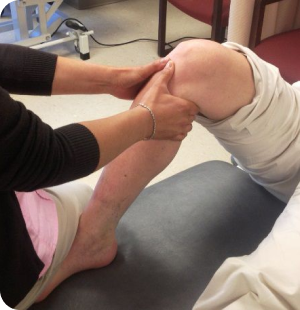Knee Ligament Injuries
Knee ligament injuries, such as ACL or MCL tears, often result from sports activities or accidents, causing instability and significant pain. These injuries can disrupt your daily life and limit your ability to participate in physical activities. Treatment typically involves precise s urgical repair or reconstruction of the damaged ligament, aimed at restoring stability and function to your knee joint. Whether you're an athlete or someone who enjoys an active lifestyle, prompt and expert care is crucial. As your orthopedic surgeon, I specialize in advanced techniques to effectively manage ligament injuries and support your recovery journey.

Frequently Asked Questions

Knee ligament injuries typically result from sudden twists, direct impact, or hyperextension of the knee joint. Sports activities that involve rapid changes in direction, such as soccer, basketball, and skiing, are common causes. The anterior cruciate ligament (ACL) and the posterior cruciate ligament (PCL) are the most frequently injured ligaments in the knee.

Symptoms of knee ligament injuries include pain, swelling, instability, and difficulty bearing weight on the affected knee. Depending on the severity of the injury, patients may experience a popping sensation at the time of injury and find it challenging to fully extend or flex their knee joint.

Diagnosis of knee ligament injuries involves a thorough physical examination and imaging studies. Dr. Jeyaraj Pradeep will assess the knee's stability, range of motion, and specific signs of ligament damage during the physical exam. Imaging techniques such as MRI (Magnetic Resonance Imaging) provide detailed images of the ligaments, helping to confirm the diagnosis and determine the extent of the injury.

Treatment for knee ligament injuries depends on the severity and type of injury. For mild to moderate injuries, conservative treatments such as rest, ice therapy, physical therapy, and bracing may be recommended. Severe injuries, particularly ACL tears, may require surgical reconstruction to restore knee stability and function. Dr. Jeyaraj Pradeep will discuss the most appropriate treatment plan based on the individual's injury, lifestyle, and goals.

Untreated or inadequately treated knee ligament injuries can lead to long-term issues such as chronic pain, instability, and an increased risk of developing knee osteoarthritis. Early diagnosis and appropriate treatment significantly improve outcomes and reduce the likelihood of long-term complications.

Recovery after knee ligament surgery involves a comprehensive rehabilitation program designed to restore strength, stability, and range of motion to the knee joint. Initially, patients may use crutches and wear a knee brace to protect the healing ligament. Physical therapy plays a crucial role in recovery, focusing on exercises to improve flexibility, muscle strength, and functional ability. Dr. Jeyaraj Pradeep will monitor progress closely and adjust the rehabilitation program as needed to facilitate optimal recovery.

Knee ligament surgery, particularly ACL reconstruction, has high success rates in restoring knee stability and function. With proper rehabilitation and adherence to post-operative guidelines, many patients achieve excellent long-term outcomes, returning to their pre-injury activity levels and enjoying improved knee function. Dr. Jeyaraj Pradeep will provide personalized care and guidance throughout the recovery process to maximize the chances of a successful outcome.

Cruciate ligament injuries commonly occur due to sudden twisting movements or direct impact to the knee. These injuries are prevalent among athletes participating in sports that involve rapid direction changes, such as soccer, basketball, and skiing. The anterior cruciate ligament (ACL) is particularly prone to injury, often resulting from a sudden pivot or awkward landing.

The meniscus acts as a shock absorber within the knee joint, helping to prevent arthritis by distributing weight and reducing friction. A meniscus injury typically presents with sudden knee pain accompanied by a snapping sound. Other symptoms may include swelling, stiffness, and difficulty fully extending or flexing the knee. Arthroscopy, or keyhole surgery, is often necessary to repair a torn meniscus or perform a meniscectomy to prevent early knee arthritis. Always consult your doctor for an accurate diagnosis.

Yes, older individuals can withstand ligament surgery, and many experience significant improvements in joint stability and function post-surgery. The success of the procedure depends on the patient’s overall health and the extent of the injury. Dr. Jeyaraj Pradeep will conduct a thorough pre-operative assessment to ensure the patient is a suitable candidate for surgery.

Ligament injuries are diagnosed through a combination of physical examination and imaging studies. Dr. Jeyaraj Pradeep will assess the knee's stability and range of motion during the physical exam. Imaging techniques such as MRI (Magnetic Resonance Imaging) provide detailed images of the soft tissues, allowing for accurate identification of ligament tears and associated injuries.

Recovery from ligament surgery typically involves a structured rehabilitation program designed to restore strength, flexibility, and function to the knee joint. Initially, patients may need to use crutches and wear a brace to protect the repaired ligament. Physical therapy plays a crucial role in recovery, with exercises tailored to gradually increase mobility and strength. Most patients can return to their normal activities within 6 to 12 months, depending on the extent of the injury and adherence to the rehabilitation program.


.png)
.png)
